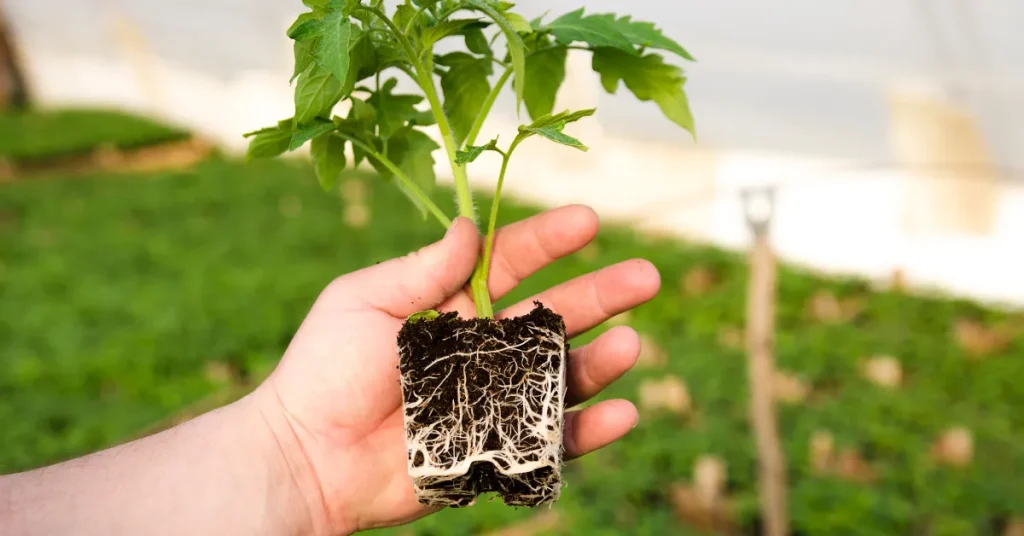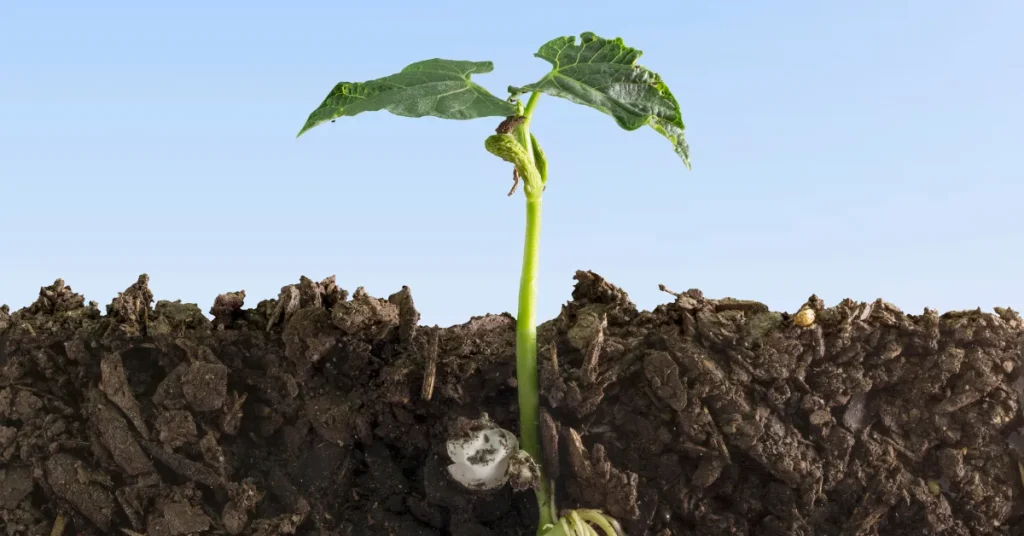Tomato roots typically extend about 1 to 3 feet deep. This depth can vary depending on the soil and water conditions.
Cultivating a thriving tomato garden starts with understanding the essentials of tomato plant growth. Tomato roots are crucial to plant health, anchoring the plant and absorbing necessary nutrients and water from the soil.
A gardener’s knowledge of root depth guides watering practices, soil preparation, and fertilization schedules, optimizing the environment for robust tomato plants.
Tomato varieties and growth conditions can influence root development, making it essential to adjust care accordingly. Ensuring a suitable depth for roots can lead to a bountiful tomato harvest, unlocking the secret to growing this popular garden staple.
Digging Into Tomato Biology
Do you ever wonder just how far down the roots of a tomato plant grow? As gardening enthusiasts, understanding the biology of tomato plants can help us care for them better.
Let’s delve into the anatomy and root systems of tomatoes to grasp what happens beneath the soil surface.
The Anatomy Of A Tomato Plant
The strength of tomato plants starts with their robust roots. The anatomy is fascinating, with each part playing a crucial role. Above the soil, we see stems, leaves, and bright red fruit. But it’s the hidden part, the roots, that fuel the plant’s growth and health.
- The main root, or taproot, digs deep for water and nutrients.
- Surrounding smaller roots spread out, creating a network.
- These roots work together, allowing the plant to stand tall and produce juicy tomatoes.
Root Systems: Types And Functions
In the tomato family, root systems come in different shapes and sizes. Each type of root has a special job that helps the tomato plant thrive.
| Type of Root | Function |
| Taproot | Digs deep for stability and finds water far below |
| Fibrous Roots | Spreads near the surface, captures moisture and nutrients |
| Adventitious Roots | Grow from stems, support the plant, and gather extra food |
While the taproot anchors the plant firmly, the fibrous roots act like skilled foragers. They collect every bit of goodness from the soil. The adventitious roots serve as the plant’s backup, ensuring survival in tough conditions.
Varieties And Their Root Depths
Did you know tomato plants vary widely in their root depths? Tomato varieties can make a significant difference in how deep and wide the roots grow. Gardeners often overlook this aspect, yet it’s vital for optimal plant health and yield.
Root depth affects water and nutrient uptake. It helps predict how much space and care these plants will need. Let’s explore the root systems of different tomato types.
Determinate Vs. Indeterminate Tomatoes
Determinate tomatoes are often called ‘bush’ tomatoes. They grow to a compact height and their roots are shallower. Indeterminate tomatoes, on the other hand, continue to grow taller and develop deeper root systems throughout the growing season.
| Type | Root Depth |
| Determinate | 18 – 24 inches |
| Indeterminate | 24 – 36 inches or deeper |
Heirlooms vs. Hybrids: Root Differences
Heirlooms Vs. Hybrids: Root Differences
Heirloom tomato varieties, with their long history, tend to have more extensive root systems. This helps them survive in diverse conditions without human intervention.
Hybrid tomatoes are bred for specific traits, including root development. Breeders may focus on creating plants with more compact roots for container gardening.
- Heirloom tomatoes: Deeper roots for nutrient uptake
- Hybrid tomatoes: Root depths vary with breeding goals
Factors Affecting Root Growth
Understanding the factors that influence tomato root growth is crucial for any gardener. Roots are vital for water and nutrient uptake. Different elements affect how deep and wide tomato roots can go.
Soil Types And Tomato Roots
Soil type plays a fundamental role in root development. Let’s explore:
- Loamy Soil: Promotes deep root expansion.
- Clay Soil: May restrict growth due to density.
- Sandy Soil: Allows roots to penetrate easily but may not hold nutrients well.
Watering Practices And Root Penetration
Irrigation habits dictate root behavior. Key points include:
- Deep watering encourages roots to grow downwards.
- Overwatering can cause roots to stay shallow.
- Consistent moisture levels support steady growth.
Impacts Of Temperature And Climate
Climate conditions are critical for healthy tomato roots. Consider these facts:
| Temperature | Effect on Roots |
| Warm | Stimulates root growth |
| Cold | Slows down growth |
| Extreme Heat | Can damage or inhibit roots |
Measuring And Observing Root Depth

Measuring and observing root depth in tomato plants plays a crucial role for gardeners and farmers alike.
Proper knowledge of root systems helps optimize growth conditions. It promotes good water and nutrient uptake. Let’s explore effective methods for examining the underground structure of these popular plants.
Techniques For Assessing Root Systems
Unearthing tomato plant roots provides valuable insights into their growth. Here are methods to measure root depth:
- Soil excavation: Carefully dig around the plant. Measure the roots’ length.
- Soil profiling: Create a soil profile wall. This reveals the root distribution.
- Transparent containers: Grow tomatoes in clear containers. Watch roots develop.
- Root tracing: Mark and trace the roots on the soil profile. Measure accurately.
- Imaging techniques: Use methods like MRI or CT scans for non-invasive observations.
Case Studies: Tomato Root Observations
Case studies bring vital real-world data to light. They show how deep tomato roots can grow:
| Study | Method Used | Max Root Depth Recorded |
| Tomato Planting in Traditional Garden | Soil Excavation | 3 feet |
| Hydroponic Tomato Cultivation | Direct Observation | 1 foot |
| Tomatoes in Raised Beds | Soil Profiling | 2 feet |
These studies reflect diverse growing methods. Each has its own root depth outcome. Optimal growing conditions and careful monitoring often lead to deeper, healthier root systems.
Cultivation Tips For Healthy Root Development
Growing robust tomato plants starts beneath the soil. Proper care ensures healthy tomato root systems.
These roots can delve deep, seeking nutrients and moisture. Focus on soil preparation, water management, and fertilization. These strengthen root systems, encouraging plants to flourish.
Optimal Soil Preparation
Well-prepared soil is crucial for deep tomato roots. Aim for a mix of loam, compost, and peat. This blend promotes drainage and aeration. Test soil pH levels; tomatoes prefer slightly acidic to neutral pH. Loose soil allows roots to penetrate deeply and spread.
Balancing Water Intake For Deep Roots
Consistent, deep watering encourages roots to grow downwards. Stick to a watering schedule.
Avoid shallow watering. Roots stay superficial otherwise. Deep watering once a week is ideal. Adjust based on weather conditions. Use drip irrigation for best results, minimizing water wastage.
The Role Of Mulching And Fertilizers
Mulch retains soil moisture and temperature. It also prevents weeds. Apply a 2-3 inch layer of organic mulch around plants.
Organic fertilizers enrich the soil. They provide necessary nutrients for root growth. Use balanced N-P-K fertilizers. These support overall plant health.
| Material | Quantity | Purpose |
| Loam | 40% | Base soil |
| Compost | 40% | Nutrient boost |
| Peat | 20% | Acidic balance |
Common Misconceptions About Tomato Roots

Many believe tomato plants have long, deep-reaching roots. This isn’t always true.
Common misconceptions about tomato roots include their length and spread.
Let’s unravel some of these root-related myths and learn what goes on beneath the soil surface.
Debunking Depth Myths
Myth: Tomato roots stretch deep like trees.
Truth: Most tomato roots stay within the top 6 inches of soil.
A table showcases typical tomato root depths for clarity.
| Tomato Type | Root Depth |
| Determinate | Up to 18 inches |
| Indeterminate | Up to 24 inches |
Deep planting encourages stronger root systems.
Root Health Vs. Length
Good root health does not equal long roots.
Healthy tomato plants need a balance.
Factors affecting root health include:
- Soil quality
- Water availability
- Nutrient balance
Focusing on root strength builds better plants, not necessarily longer roots.
Providing the right conditions matters more than chasing depth.
Dig deeper into root care, not just root depth.
FAQs About How Deep Do Tomato Roots Go
How Deep Can Tomato Plant Roots Grow?
Tomato roots can grow up to 3 feet deep in well-cultivated soil. However, the majority of the roots typically stay within the top 6 to 12 inches. Root depth can be influenced by soil type and watering practices.
Do Deeper Tomato Roots Enhance Plant Health?
Deeper tomato roots can improve plant health by accessing more nutrients and water. This can lead to better drought resistance and a stronger, more stable plant. Encouraging deep root growth can be beneficial for overall tomato plant vitality.
What Factors Affect Tomato Root Depth?
Soil composition, watering routines, and plant variety impact tomato root depth. Compacted or clay-heavy soils can restrict growth, while loose, well-draining soils promote deeper roots. Consistent, deep watering encourages roots to grow downward.
Can I Grow Tomatoes In Shallow Soil?
Yes, tomatoes can grow in shallow soil, but with limitations. Shallow soils dry out quickly and may offer fewer nutrients. For best results, consider using raised beds or containers with nutrient-rich potting mix and frequent watering.
Conclusion
Exploring the depths of tomato roots uncovers a fascinating aspect of gardening.
Remember, your tomato plants thrive with roots spreading between 1 to 3 feet deep, promoting healthy growth and bountiful harvests. To optimize your yields, consider root depth in garden planning.
Happy gardening and bounteous tomato harvests ahead!
Resources:
1. https://extension.umn.edu/plant-diseases/tomato-disorders
